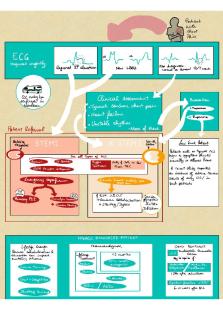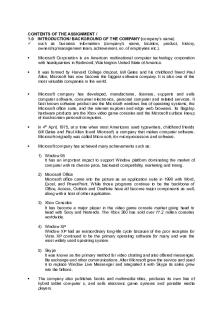Parallel Dilution Set Infographic PDF

| Title | Parallel Dilution Set Infographic |
|---|---|
| Course | General Chemistry I |
| Institution | University of Arizona |
| Pages | 1 |
| File Size | 144.7 KB |
| File Type | |
| Total Downloads | 67 |
| Total Views | 144 |
Summary
Parallel dilutions for lab 2...
Description
Chemical Thinking
A dilution set is a group of solutions prepared by diluting a substance dissolved in a liquid. For the vast majority of cases the objective of building a dilution set is to create dilutions of defined concentration from a single “stock” or original solution of known concentration. In a parallel dilution the stock serves as the sole source for all the dilutions (as opposed to serial dilutions in which each dilution serves as the source for the subsequent dilution). An advantage of parallel dilutions over serial dilutions, is that errors tend to have less significance as one dilution error is not likely to affect the others. Some definitions:
A stock solution is the original solution of known concentration from which the dilution set is built.
A diluent is a liquid by which the sample is diluted. If 550 µL (0.55 mL) of stock is added to 4.45 mL of solvent, then the 4.45 mL of solvent is diluting the 550 µL of stock, and so is the diluent.
When building a parallel dilution you should consider what volume of each dilution ( VD) is actually required given the instrumentation involved. For example, finding the molar absorptivity from an A vs. C plot with a spectrophotometer using a standard cuvette requires no more than 3 mL of each dilution. Hence, it would be poor technique, and incredibly wasteful, to prepare a dilution set with 100 mL of each dilution. In this case, 97 mL of each dilution would go to waste! A volume of 5 mL would be far more appropriate.
v1.4 | 1
Parallel Dilution Set
VS
NANOpure
Pa Dil The diagram above represents the preparation of a parallel dilution set with each dilution (diluted volume, VD) at 5.00 mL. Here VS is the volume of stock solution and Vdiluent the volume of diluent (NANOpure™ water) required to achieve each dilution. It is helpful to realize the diluted volume (sometimes called the total volume), VD, is just the sum of the stock volume, VS, and diluent volume, Vdiluent: Eqn 1 𝑉𝐷 = 𝑉𝑆 + 𝑉𝑑𝑖𝑙𝑢𝑒𝑛𝑡 Please DO NOT TO CONFUSE the diluent volume, Vdiluent, with the diluted volume, VD, which is the sum of the stock volume, VS, and the diluent volume, Vdiluent. Remember, the objective is to create dilutions of defined concentration from a single “stock” of
Vdiluent
known concentration. This implies we need to calculate the resulting concentration of each dilution. The key to such dilution calculations is the relationship: Eqn 2 𝐶𝑆 𝑉𝑆 = 𝐶𝐷 𝑉𝐷 In this equality CS is the concentration of the stock solution, VS, the volume of stock solution, CD, the concentration of the dilute sample and VD, its volume. To calculate the concentration of a diluted solution knowing the concentration of the stock solution, solve Eqn 2 for CD: 𝐶𝑆 𝑉𝑆 𝐶𝐷 = 𝑉𝐷 and then substitute in the appropriate values for the stock concentration, the volume of stock used and the volume of diluted solution....
Similar Free PDFs

serial dilution
- 3 Pages

Infographic Assignment
- 2 Pages

Mindfulness Infographic
- 1 Pages

Infographic MKT558
- 2 Pages

Stigma Infographic
- 1 Pages

Infographic - Activity
- 1 Pages

ACS - ACS Infographic
- 2 Pages

Assignment MGT Infographic
- 3 Pages

Individual Infographic Chapter 7
- 6 Pages

Titration and Dilution Lab
- 6 Pages

Parallel Circuits
- 50 Pages

Assignment 15 Dilution Quiz
- 4 Pages
Popular Institutions
- Tinajero National High School - Annex
- Politeknik Caltex Riau
- Yokohama City University
- SGT University
- University of Al-Qadisiyah
- Divine Word College of Vigan
- Techniek College Rotterdam
- Universidade de Santiago
- Universiti Teknologi MARA Cawangan Johor Kampus Pasir Gudang
- Poltekkes Kemenkes Yogyakarta
- Baguio City National High School
- Colegio san marcos
- preparatoria uno
- Centro de Bachillerato Tecnológico Industrial y de Servicios No. 107
- Dalian Maritime University
- Quang Trung Secondary School
- Colegio Tecnológico en Informática
- Corporación Regional de Educación Superior
- Grupo CEDVA
- Dar Al Uloom University
- Centro de Estudios Preuniversitarios de la Universidad Nacional de Ingeniería
- 上智大学
- Aakash International School, Nuna Majara
- San Felipe Neri Catholic School
- Kang Chiao International School - New Taipei City
- Misamis Occidental National High School
- Institución Educativa Escuela Normal Juan Ladrilleros
- Kolehiyo ng Pantukan
- Batanes State College
- Instituto Continental
- Sekolah Menengah Kejuruan Kesehatan Kaltara (Tarakan)
- Colegio de La Inmaculada Concepcion - Cebu



